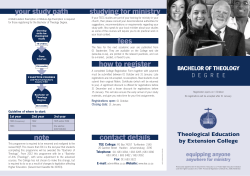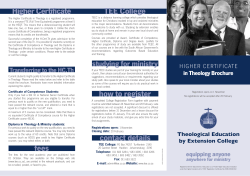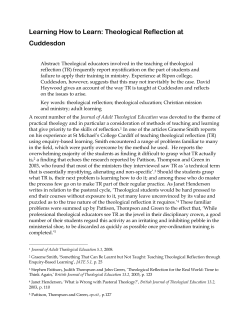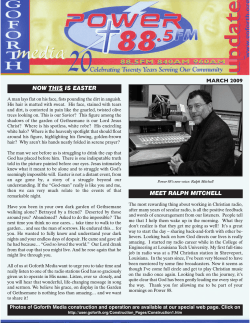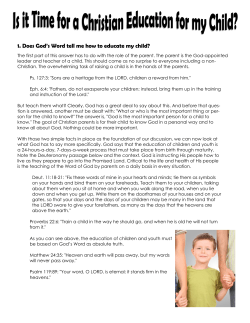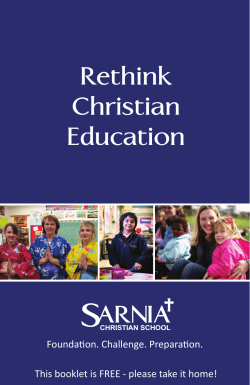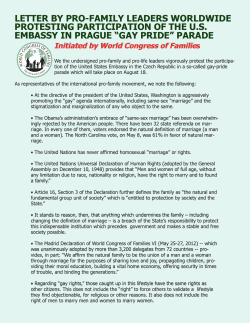
What was “Postliberalism”? What is the “Postliberal Perspective” Today? Introduction
Introduction What was “Postliberalism”? What is the “Postliberal Perspective” Today? In Iris Murdoch’s dialogue between Socrates and his friends about what is religion, a fictional character named Antagoras takes the part of the atheist: SOCRATES: You don’t believe in divine spiritual beings? ANTAGORAS: No! And if there were such beings we would be their judges. Any god who existed would be just a thing in our world, which we could decide about. It’s not that God must exist, or might exist, it’s that he can’t exist. We are the source of morality and rational judgment. Once we understand this we can’t believe in gods. We can’t go back once we’ve become rational and free, it’s an irreversible move. SOCRATES: We are the gods now? ANTAGORAS: Yes, if you like. The gods were just ideal pictures of us; we have to get rid of them to realize our own possibilities. Much later in the dialogue, Socrates reveals his own position: SOCRATES: … We are not gods, we are absurd limited beings, we live with affliction and chance. The most important things are close to us, the truth is close, in front of our noses, like the faces of our friends, we need no expert to tell us. Religion is our love of virtue lightening the present moment. It is respect for what we know, and reverence for what we don’t know, what we can only approach, where our not-knowing must be our mode of knowing, where we make symbols and images, then destroy them, and make other ones, as we see now in our own time. Images are natural, art is natural, sacraments and pictures and holy things are natural, the inner and the outer reflect each other, there is a reverence which finds what is spiritual everywhere in the world, he is right (pointing to the servant), God is everywhere. If we love whatever God we know and speak to Him truthfully we shall be answered. Out at the very edge of our imagination the spirit is eternally active. Respect the pure visions that speak to the heart, find there what is absolute. That is why we go to a holy place and kneel down. There is nothing more ultimate than that. (Pause) Iris Murdoch, “Above the Gods: A Dialogue about Religion”, in Peter Conradi, (ed.), Existentialists and Mystics: Writings on Philosophy and Literature / Iris Murdoch (Harmondsworth, Middlesex, U.K. and New York: Penguin Books, 1999), 496–531. The quotations are taken from pp. 499 and 525. Originally published in Iris Murdoch, Acastos: Two Platonic Dialogues (London: Chatto and Windus, 1986). God in Postliberal Perspective Who is “G-o-d” for “us” today? Specifically, who is the “God” worshipped by Christians in the variety of global settings in this ecumenical and interfaith age? Does it still make sense to speak as if all Christians worship one God, the Father, Son, and Holy Spirit, into whose name we are all baptized? Or, following the trail of modern pluralism and late modern scepticism, should we speak of multiple images and doctrines of “God” among the diversity of Christians? And what about the diversity of Jews and Muslims? Should we speak of the variety of images of “God” rather than assume a false essentialism in the name of “the one God” or in the name of a violent monotheism? How do we come to terms with the variety of images, symbols, metaphors, stories, and concepts used to refer to “God” by communities and persons who identify with the name “Christian”? In practice, do Christians not fall somewhere between an ideal monotheism and a heterogeneous polytheism? Does not the very variety of ways of naming God in different contexts and churches suggest that all our talk about “God” is a type of fiction, human constructions of “the divine” that meet different needs and purposes in different contexts? So we move in liturgical language from the patriarchal construction of God as “Father” and Christ as “Son” to the feminist constructions of God as “Mother”, “Parent”, “Friend”, “Partner”, and “Verb”. Or in academic contexts we move from the classical substantialist account of the God of theism, constructed in terms of the metaphysics of substance and presence, to a modern process account of God as dynamic, evolving, being enriched by the world and suffering its evils. Or we deconstruct the metaphysics of both substantialist and process accounts of God in the name of a new negative theology which gestures toward the absence of God in hopeful silence, awaiting a messianic future with no specific messiah. Or giving up on the metaphysics of all Thomisms, we dare to speak of a “God without Being” in the space opened up by agapic love, the Eucharistic gift that is utterly gratuitous. The variety of options bedazzles us and in the end we stand condemned to the tyranny of our own choices and the contingencies of our autobiographies, Regina M. Schwartz, The Curse of Cain: The Violent Legacy of Monotheism (Chicago: Univ. of Chicago Press, 1997). H. Richard Niebuhr, “The Doctrine of the Trinity and the Unity of the Church.” Theology Today 3 (1946–47):371–84., idem, “Theological Unitarianisms.” Theology Today 40 (1983–84):150–57; idem, Radical Monotheism and Western Culture (New York: Harper & Row, 1960); Diana Eck, Encountering God: A Spiritual Journey from Bozeman to Banaras (Boston: Beacon Press, 1993), Chap. 3 “The Names of God.” John D. Caputo, “The Messianic: Waiting for the Future”, in Deconstruction in a Nutshell: A Conversation with Jacques Derrida (New York: Fordham Univ. Press, 1997), 156–80. For a fuller exposition, see idem, The Prayers and Tears of Jacques Derrida: Religion without Religion (Bloomington, IN: Indiana Univ. Press, 1997), 117–59. Jean-Luc Marion, God Without Being: Hors-Texte, Thomas A. Carlson, (trans.) (Chicago and London: Univ. of Chicago Press, 1991). What was “Postliberalism”? What is the “Postliberal Perspective” Today? constructing “God” to meet temporary needs, concerns, and styles of discourse. Pluralism collapses into contextual relativity and historicist fate, and then glides down the surfaces of life without a centre and certainty into relativism, subjectivism, and nihilism. In this new millennium, a post-metaphysical atheism (denying the “God” of western theism, the god “In Whom We Trust” on the US dollar bill) or a pluralist agnosticism appear to be the only responsible stances for those who care enough to think and pay the price for thinking. The history of critical thinking about “God” over the last three centuries seems to have reached some kind of ending in our times. What of “God” after the end of modern history as we have known it? In the light of these problems, influences, and the “sense of an ending”, the doctrine of God in late twentieth-century Christian theology underwent multiple revisions. One of those attempts flourished under the title of “postliberal”. The term signified a group of Christian and some Jewish scholars and clergy who sought to break out of the modern, liberal paradigm of doing theology to address a new age of rapid social change and anxiety in the historic mainline (or ‘oldline’) institutions of religious and academic life. The very term “postliberal” had multiple meanings. For some it signified the end of one liberal way of doing For an insider’s brief account, see William C. Placher, “Postliberal Theology”, Chap. 18 in David F. Ford, (ed.) The Modern Theologians: An Introduction to Christian Theology in the Twentieth Century, second edn. (Cambridge, MA and Oxford, UK: Blackwell Pub., 1997), 343–56. Also see George Hunsinger, “Postliberal Theology”, Chap. 3 in Kevin J. Vanhoozer, (ed.) The Cambridge Companion to Postmodern Theology (New York: Cambridge Univ. Press, 2003). For selections and introductions to some of the crucial texts, see John Webster and George P. Schner, (eds), Theology After Liberalism: A Reader (Malden, MA and Oxford, UK: Blackwell Pub., 2000). For a synthetic account that situates postliberalism in relation to liberationist and revisionary theologies, see David G. Kamitsuka, Theology and Contemporary Culture: Liberation, Postliberal and Revisionary Perspectives (Cambridge, UK: Cambridge Univ. Press, 1999). For a Roman Catholic reception, see Jeffrey C. K. Goh, Christian Tradition Today: A Postliberal Vision of Church and World, Louvain Theological and Pastoral Monographs 28 (Louvain, Belgium: Peeters Press; Grand Rapids, MI: Eerdmans, 2000). For a neo-pragmatic revision of Lindbeck’s methodology, see C. C. Pecknold, Transforming Postliberal Theology: George Lindbeck, Pragmatism and Scripture (London and New York: T. & T. Clark, 2005). For the reception of Lindbeck’s program in the Francophone world, see Marc Boss, Gilles Emery, and Pierre Gisel, (eds) Postlibéralisme? La Théologie de George Lindbeck et sa Réception (Genève: Labor et Fides, 2004). For a constructive critique of how Hans Frei and George Lindbeck were misread, see Paul J. DeHart, The Trial of the Witnesses: The Rise and Decline of Postliberal Theology (Malden, MA and Oxford, UK: Blackwell Pub., 2006). Concerning Jewish philosophers influenced by Lindbeck, see Steven Kepnes, Peter Ochs, and Robert Gibbs, Reasoning After Revelation: Dialogues in Postmodern Jewish Philosophy (Boulder, CO and Oxford, UK: Westview Press, 1998). George Lindbeck wrote, “The type of theology I have in mind could also be called ‘postmodern,’ ‘postrevisionist,’ or ‘post-neo-orthodox,’ but ‘postliberal’ seems best because what I have in mind postdates the experiential-expressive approach which is the mark of God in Postliberal Perspective theology and being the church that had its last stand in the popularity of liberation theologies in the 1960s and 70s. For these Christians, liberalism had been at the core of their theological training and ecumenical outlook. Its fragmentation in the late 1960s and concessions to pluralism in the 1970s and 80s signalled the end of an era when political and theological liberals could influence both the church in theology and society in politics. Others who joined the postliberal cause never had a liberal bone in their bodies. Postliberal theology was their way as Evangelicals, Pentecostals, or Roman Catholics to enter the theological conversation on new terms that preserved distinctive contributions of their own traditions. This distinction between postliberals who remembered a liberal past and postliberals without a liberal heritage contributed to the confusion in theology about what it meant to claim the title. Postliberalism became another plural social reality. The postliberal moment in theology opened the door for a variety of re-readings of traditional Christian doctrines of God. On the one hand it could draw on the “first postliberal” movement in American theology, so-called neo-orthodoxy or dialectical theology (1919–1965). Along with the first postliberalism, the new movement sought to retrieve classic doctrines and practices of the faith rather than radically revising them into fashionable new forms and trendy fads. Thus it was committed to reflection on the doctrine of God in the context of trinitarian and christological confession from Early Church, Medieval, and Reformation sources. At the same time, it contributed to a new scripturalism in theology that took seriously the critical insights of post-structuralism and other pre- and postmodern ways of reading texts. The hegemony of historical criticism and the hermeneutics of Bultmann’s generation, especially the more positivist versions of its assumptions, methods, and results, were directly and seriously challenged by the second postliberal movement.10 liberal method. This technical use of the word is much broader than the ordinary one: methodological liberals may be conservative or traditionalist in theology and reactionary in social or political matters, e.g., the ‘pro-Nazi Deutsche Christen’.” The Nature of Doctrine: Religion and Theology in a Postliberal Age (Philadelphia: Westminster Press, 1984), 135, note 1. James C. Livingston, “Christian Realism: Post-Liberal American Theology”, Chap. 15 in Modern Christian Thought: From the Enlightenment to Vatican II (New York: Macmillan; London: Collier Macmillan, 1971), 446–77.; Chap. 6 in James C. Livingston and Francis Schüssler Fiorenza, Modern Christian Thought, vol II: The Twentieth Century, second edn (Upper Saddle River, NJ: Prentice Hall, 1997). 10 Stephen E. Fowl, Engaging Scripture: A Model for Theological Interpretation (Malden, MA and Oxford, UK: Blackwell Pub., 1998). Background readings are collected in Stephen E. Fowl, The Theological Interpretation of Scripture: Classic and Contemporary Readings (Cambridge, MA and Oxford, UK: Blackwell Pub., 1997). See especially David C. Steinmetz, “The Superiority of Pre-Critical Exegesis”, 26–38. On the problematic relation between historical-criticism and biblical narrative, see Hans W. Frei, The Eclipse of Biblical Narrative: A Study in Eighteenth and Nineteenth Century Hermeneutics (New Haven, CT and London: Yale Univ. Press, 1974). The debate over the appeal to biblical and Christian What was “Postliberalism”? What is the “Postliberal Perspective” Today? On the other hand, the new postliberalism was much more open to the contributions of past and present philosophy (first analytic and more recently postmodern philosophy) to the tasks of theology than the first postliberalism. Plato, Aristotle, Augustine, Anselm, Aquinas, and other classic figures in western philosophical theology were full partners in the postliberal conversation. The critiques of early modern (e.g., Descartes and Locke) and Enlightenment figures (e.g., Hume and Kant) by philosophers like Wittgenstein, Rorty, and MacIntyre were central to the postliberal suspicion about modernity and its projects of political and theological liberalisms. A new historicist attitude toward modernity developed that showed influences of philosophers like Hegel, Husserl, Heidegger, Gadamer, Ricoeur, Foucault and Derrida. Since I am not an insider to the Yale school of postliberalism, I will cite two insider definitions. In an overview chapter on “Postliberal Theology”, William Placher proposes the following four characteristics.11 I will add a fifth: 1. Postliberal theology is “non-foundationalist”. It has given up on the modern quest for foundations of certainty upon which to ground all claims to scientific or religious knowledge. Since “experience always comes already interpreted”, one cannot evaluate beliefs “by checking them against some primordial, uninterpreted experience” (344). Rather, postliberal arguments for the justification of religious beliefs tend to be holistic and seek justification by coherence rather than correspondence. They grow out of ongoing interpretive traditions, seek coherence with other shared beliefs, and periods of reflective equilibrium rather than certainty. 2. It avoids “systematic apologetics”. Given the turn away from foundations of certainty, there is no one privileged philosophy or framework in which theological claims become meaningful and true. Rather, postliberals engage in ad hoc, contextual translations and justifications of their claims reflecting the distinctiveness of Christian convictions within the wider pluralism of contemporary life. 3. Its concern is for the “differences among religions” rather than the lowest common denominator or essence behind their particulars. The turn away from foundations and systems is linked to a valorization of religious differences. As Yale philosopher William Christian wrote of interfaith dialogue: “understanding one another does not always lead to agreement and … respect for one another does not depend on agreement” (345). 4. “It emphasizes the scriptural stories … by which Christians identify God and the Christian community and come to understand their own lives” (345). This fourth characteristic grows out of two practices: the first is, “attending to the shape of the biblical texts as we have them, especially the structures narratives in theology is collected in Stanley Hauerwas and L. Gregory Jones, (eds.) Why Narrative? Readings in Narrative Theology (Eugene, OR: Wipf and Stock Pub., 1997). 11 William Placher, “Postliberal Theology.” Hereafter citations are in parentheses. God in Postliberal Perspective of their narratives, utilizing techniques analogous to those of literary critics” (344). The second practice is, “thinking about the relations of biblical texts to the communities that read them – how the narratives shape the identities of those communities, their members, and their understandings of the God they worship” (ibid.). 5. A “generous orthodoxy”. I add a fifth characteristic to this list. Many postliberals share a concern for what Hans Frei (1922–1988) called a “generous orthodoxy” in theology and church. Their turn away from the liberal tradition is motivated by a sense of loss, of a fall that occurred in modernity. Frei’s account of the eclipse of biblical narrative in early modern hermeneutics, Michael Buckley’s story in At the Origins of Modern Atheism of the turn toward metaphysical and scientific foundations alone for belief in God in early modern theology, and Placher’s narrative of the domestication of transcendence in modern doctrines of God all speak to this sense: today we do theology after a great fall. Breaking that fall, recovering part of what was lost, then, sets the agenda for postliberal theology. For Frei that meant learning how to read biblical narrative in ways in which readers become figures within the storied world. For Buckley it means recovering christology, pneumatology, and the history of Christian experience as the proper testimony to faith in God. For Placher it means relearning the dialectic of the hidden and revealed God known to the generations of Aquinas, Luther, and Calvin. This is a generous orthodoxy because its roots are ecumenical. It engages in a critical study of the history of Christian thought to uncover the contingent and contextual decisions that shape our present sense of constraint. It mines those same historical veins to imagine new possibilities for reading the Bible and tradition on different terms today. Another way to characterize postliberal theology on its own terms comes from Hans Frei’s five types of Christian theology.12 This is definition by contrast with four major alternatives to the postliberal way. For the sake of brevity I will follow David Ford’s summary of the five types:13 Type 1: The first type falls on the extreme end of the continuum. It gives first importance to a “contemporary philosophy, worldview, or practical agenda” and approaches theology on those terms. Thus Ford summarizes, … [Type 1] treats Christian theology from the outside, coming to it with a mind … already made up and simply using [theology] within its own framework where Hans W. Frei, Types of Christian Theology, George Hunsinger and William Placher, (eds) (New Haven, CT: Yale Univ. Press, 1992). 13 David F. Ford, Theology: A Very Short Introduction (Oxford, UK: Oxford Univ. Press, 1999), 20–29. Hereafter citations are in parentheses. 12 What was “Postliberalism”? What is the “Postliberal Perspective” Today? it fits. Yet [this type] represents a very common attitude to … theology in our culture: assuming it is outdated, untrue, immoral, or imaginatively restrictive, approving of it when it fits one’s own framework, but not having any serious dialogue with theology or allowing it any practical influence. Often it is simply ignorant of the best in theology, and is working with caricatures of Christianity; but, even when it is well informed, it frequently displays … the ‘superiority complex’ of much modernity (22–3). Frei’s primary case study for this rationalist type is Gordon Kaufman. Here theology becomes “a philosophical discipline, and its endeavour to grapple with specific Christian … self-description is not only subordinate to, but undertaken as part of, a general intellectual-cultural inquiry.”14 The academy and an abstract concept of “western culture” become the primary contexts for doing theology. Type 5: The fifth type falls at the other extreme end of the continuum. This is an “attempt to repeat a scriptural worldview, classic theology, or traditional version of Christianity, and to see all reality in those terms”. Contemporary philosophy, worldviews, or agenda are rejected. “Type 1 cuts off dialogue because it is convinced of the superiority of its own external framework; Type 5 cuts off dialogue because it is convinced that some internal Christian framework is sufficient” (23). Some forms of fundamentalism exemplify this type. But a certain appeal to Wittgenstein’s notion of language games and forms of life as macro phenomena also fits. Ford summarizes this version of Type 5: … we are all involved in complex ‘languages’ through which our understanding, behavior, and imagination are shaped. Christianity is one such language game, it has its own integrity, and you should not judge it by the rules of other games any more than you would apply the rules of chess to tennis. Therefore it cannot be adequately explained in terms of other language games such as … [naturalism, rationalism, Islam, etc.] The task of theology is to make clear what sort of ‘game’ Christianity is and to draw the consequences for living within it. It is pointless to try to justify Christian faith in alien terms – that would be to switch games (24). Frei’s primary example of a Wittgensteinian philosopher within this type is D. Z. Phillips. Type 2: Between these two extremes fall three other types that represent what Ford considers the mainstream of academic theology (24). The second type … takes external frameworks seriously but also wants to engage with what is distinctive in Christian theology. Among the external philosophies and worldviews some are more suited to Christian faith than others. Why not choose Frei, Types of Christian Theology, 30. 14 God in Postliberal Perspective one of these and then apply it to understanding Christianity and showing how faith makes sense and is relevant today? (24–25). Ford’s example of Type 2 is Bultmann’s turn to existentialist philosophy as the framework into which the Christian message should be translated in order to communicate with so-called “modern humanity” in our scientific era. “The mark of Bultmann’s strategy is … the use of contemporary thought to reinterpret what he sees as the core of the Gospel and to abandon the rest” (25). Frei’s example is the hermeneutic-phenomenological approach of David Tracy in Blessed Rage for Order. The historical and hermeneutical search for this core or the essential elements to be translated into the chosen contemporary framework is one sign of the liberal spirit at work in Type 2 theologies. Type 3: The third type falls in the middle of the continuum where it refuses to privilege any one framework for its translation project. Its formula is: “avoid any systematic way of relating Christianity and other forms of understanding, and instead set up dialogues between them” (26). The method here is ‘correlation’: one should “correlate issues raised by Christian faith and practice with other approaches to those issues. Until you enter into the dialogues you cannot predict what will be most illuminating” (ibid). Whereas existentialism may enable a correlation of “human anxiety and insecurity” with the Gospel, it may be of little use in correlating issues of cosmology and God as Creator. Ford’s example is Tillich’s project to “correlate faith with culture.” Frei’s case study is Schleiermacher although he admits that he may not fit Type 3. According to Frei, Schleiermacher’s theology sought to answer the question, “How is Christian self-description related to external descriptions of Christianity?”15 In the prolegomena to The Christian Faith, his method is to lead the reader “more and more toward a place where you will replicate, as it were from your own inside or by placing yourself within the conspectus of religious life, what he has been saying to you as a kind of didactic specialist”.16 Schleiermacher seeks to retain the integrity of Christian self-description while correlating it with external descriptions of Christian experience and expression, e.g., philosophical, phenomenological, or historical accounts that are offered within the academy. The two forms of description are “autonomous yet reciprocally related”.17 Ford describes Type 3 as a “middle way”. According to its critics, theologians like Schleiermacher and Tillich had great difficulty maintaining the balance between faith and culture, between Christian self-description and external accounts. Type 4: The fourth type is the postliberal approach. It gives first importance to Christian self-description. Seeking to avoid the extreme of Type 5, it “still insists that no other framework should be able to dictate how to understand the main 15 Ibid. 35. Ibid. 36. 17 Ibid. 38. 16 What was “Postliberalism”? What is the “Postliberal Perspective” Today? contents of Christian faith” as in the extreme of Type 1. Lindbeck once called this approach “Anselmian scripturalism”. “It is ‘faith seeking understanding’, basically trusting the main lines of classic Christian testimony to God and the Gospel, but also entering into a wide range of dialogues” like Type 3. It considers Type 3 as “inherently unstable: there can be no neutral standpoint from which to carry on dialogues, and therefore there has to be a basic commitment either for or against Christian faith.” This type of theology “acknowledges a basic commitment in faith, but also the need continually to test it and relate it to other positions.” For Type 4 postliberals, according to Ford: Christian faith is not just an intellectual position, but is also a way of life in a community that stretches around the world and down the centuries. If you live in that community, you cannot pretend to be neutral yet you will want to seek truth wherever it is found, and type 4 is one way of doing this. If you are not a Christian you may still value type 4 highly because you want to know what an intelligent mainstream Christian understanding is like in order to be clear what there is to agree or disagree with (27). Both Frei and Ford offer Karl Barth as the case study in Type 4 theology. Indeed, much postliberal theology is pursued in the shadow of Barth (1886–1968). If we return to the five characteristics of postliberal theology with which we began, Barth’s influence is pervasive. Although a reader of Barth’s doctrine of revelation in Church Dogmatics I/1 would hardly characterize him as a nonfoundationalist who had given up on certainty as a mark of the knowledge of faith, his way of doing theology avoids certain forms of foundationalism. As Frei notes, “Barth leaves absolutely no doubt that for him, unlike Schleiermacher, fundamental theology … is internal to, part of, the dogmatic enterprise. It is not a procedure for correlating theology to other disciplines in the academic spectrum.”18 Barth refused to build his dogmatics on the foundations of (a) natural theology; (b) systematic metaphysics; (c) historicist recoveries of Jesus; (d) an existentialist anthropology per se. This refusal prefigures the postliberal turn toward nonfoundational epistemology. The refusal to offer a systematic apologetics is also prefigured in Barth’s famous debate with Emil Brunner over natural theology. His ad hoc approach to engaging thinkers from other traditions and frameworks within the excursuses of Church Dogmatics and in his “irregular dogmatic” writings is a model for postliberals. Barth not only accentuated the differences between religions but also the differences between different expressions of Christian doctrine and forms of theology. In fact, he attempted to claim a critical difference between God’s revelation in Christ and all forms of human religion, including Christianity. When my students in Chicago read Barth for the first time, they are often struck by how 18 Ibid. 39. 10 God in Postliberal Perspective much he shares in common with his partners in debate but how often he underrates their common ground. His theological exegesis of biblical narrative is also a model for postliberals. His attempt to understand all reality and all Christian doctrine in light of a biblicalnarrative world centred on Jesus Christ inspired Frei’s notion of absorbing the world of human experience into the world of scriptural stories. Finally the postliberal goal of a generous orthodoxy is modelled by Barth’s attempt to write a theology that is scriptural, contextually modern, and ecclesial for persons engaged in church and society. In his doctrine of Scripture in Church Dogmatics I/2, Barth does not cast out historical-criticism but claims it as a necessary preparation for theological exegesis. Nor does Barth confine himself to mere repetition of previous dogmas, e.g., he reverses the traditional order by treating God as Trinity before he takes up the doctrine of divine unity. And within his doctrine of God, he engages in a creative, christocentric recasting of divine election, a work of theological critique and revision of Calvin and reformed notions of predestination. If these are some of the characteristics of postliberalism, what are some of the challenges facing the doctrine of God today that should concern postliberals at some level? Here are six of the most important: Appeals to realism and other challenges Challenge 1: As it turned away from the apologetic and accommodating approaches of liberal theology, postliberal theology was called to task for its account of Christian truth-claims under the issues of reference and rationality.19 Were second wave postliberal accounts of the justification of faith in God any less circular and question-begging than so-called neo-orthodox appeals to special revelation? Didn’t the privileged postliberal categories like narrative, community, identity, character, and tradition become inflated with meanings that simply ignored issues of historical-critical scholarship, academic freedom, the segmentation of life in secular societies, and the renewed influence of science, technology, and global capitalism in every sector of life? At bottom, were not postliberals subject to a fideism, relativism, and sectarianism inspired by Wittgenstein’s over-simplified accounts of language-games and forms of life? Finally, was it accidental that these neo-liberal charges of fideism, relativism, and tribalism came in the midst of the resurgence of Islam on the field of politics and debates over multi-cultural curricula in public and theological education? Challenge 2: The neo-liberal reaction to postliberal accounts of the justification of faith in God was joined by conservative theological voices. In their accounts of Scripture, doctrine, authority, and God, postliberals sounded like non-realists 19 Mark I. Wallace, The Second Naiveté: Barth, Ricoeur, and the New Yale Theology (Macon, GA: Mercer Univ. Press, 1990), Chap. 4, “The New Yale Theology”. What was “Postliberalism”? What is the “Postliberal Perspective” Today? 11 to many readers who were otherwise sympathetic to their critiques of modernity and liberal revisionism.20 In some ways, this was due to the confusion over the meaning of The Nature of Doctrine by Lindbeck. What the author intended was a pre-theological account of the nature of doctrine in a variety of religious and cultural settings, a kind of neo-Thomistic natural theology of doctrine as a cross-cultural religious practice. When this pre-theological account was read as a positive theological account of the authority and reference of Christian doctrines per se, confusion multiplied. The fact that most of Lindbeck’s examples were drawn from Christian sources did not help. And the fact that some postliberals then used this account to try to solve intra-Christian theological problems of methodology, hermeneutics, and doctrine only compounded the confusion. As an exercise in meta-theological reflection, The Nature of Doctrine solved or resolved little for Christian theologians working on specific doctrines per se, or questions like the status of experience as subject matter for doing theology (an issue better addressed by Nicholas Lash in conversation with Lindbeck).21 However, for theologians engaged in ecumenical and interfaith dialogue, the text became an invaluable resource for focusing the conversation in new ways that responded to a late modern awareness of cultural dynamics and theological openness to both classic and contemporary insights. Challenge 3: Internal to postliberalism, Ronald Thiemann summarized the issue of the knowability of God most succinctly: How can we claim to have knowledge of God? If we bring God into a context dominated by our categories and concepts, we treat him as if he were simply another object among the many objects we know through rational schematization. If we set God outside that framework and allow him to create his own conditions and content of knowledge, then we cannot say how it is that we know him. The former option denies God his divinity; the latter denies us our humanity.22 This neo-Kantian formulation of the very problem of the knowability of God (rational schematization vs subjective appropriation and the trace of subject/object dualism) reveals one way in which postliberalism was still a liberalism or form of modern reflection about God. Once this neo-Kantian way of setting up the problem is called into question, postliberalism must encounter other ways of imagining the Timothy R. Phillips and Dennis L. Okholm, (eds), The Nature of Confession: Evangelicals and Postliberals in Conversation (Downers Grove, IL: InterVarsity Press, 1996). See especially Chap. 3 by Miroslav Volf, “Theology, Meaning and Power: A Conversation with George Lindbeck on Theology and the Nature of Christian Difference”, and the essays in “Part III Realism and Foundationalism”. 21 Nicholas Lash, Easter in Ordinary: Reflections on Human Experience and the Knowledge of God (Charlottesville, VA: University of Virginia Press, 1988). 22 Ronald F. Thiemann, Revelation and Theology: The Gospel as Narrated Promise (Notre Dame, IN: Univ. of Notre Dame Press, 1985), 42–3. 20 God in Postliberal Perspective 12 reality of God and the meaning of faith’s knowledge of God – how did postliberal theology relate itself to the revision of notions of realism and non-realism going on in other disciplines, e.g., the philosophy of science (Kuhn-Feyerabend-Lakatos debates), cross-cultural studies of rationality and realism in the social sciences, the postmodern critique of truth, objective knowledge, and universality as false totalizations and expressions of power relations, and post-structuralist literary criticism which focused on ways readers construct the meanings of texts rather than discover a normative author’s intended meaning? In Thiemann’s case, he appealed to a new version of the doctrine of revelation which was explicitly trinitarian and claimed to find in Matthew’s gospel a scriptural ground for his claim that “the selfdifferential unity we observe in God’s narrative relations is a reiteration of God’s inner but hidden identity”.23 But can his assumption that “the world depicted by the Bible is the only real world” survive critical scrutiny, especially in an interfaith and secular age with access to much more historicist ways of interpreting biblical narratives, placing in sharp relief the fragility of postliberalism in the old-line churches, the late modern academy and society?24 Challenge 4: From the perspective of political theology, other questions were raised. Given postliberalism’s appearance at a time of neo-conservatism in western politics (the era of Reagan, Bush and Thatcher, the collapse of Communism, and the crisis of the international Left) and in religious institutions (e.g., the backlash against feminism, the formal exclusion of gay and lesbian Christians from many church offices, and the emergence of neo-Evangelical and Pentecostal mega-churches and global movements), wasn’t this scholarly movement another manifestation of conservative reaction against the pluralism and secularity of the late modern age, and the decline of the influence of religious elites and churchrelated institutions? Challenge 5: The internal political and ecclesiological pluralism of postliberals themselves became an issue. While some were attracted to the congregational turn among Protestants newly opened to the witness of the Anabaptist tradition, others sought to shore up notions of civic responsibility and critical citizenship among the faithful. Where is the true church or congregation in which faith in God is well-formed? What are the relationships of such congregations to a plural, interfaith society? Were postliberals called to a new Christian “realism” in politics, a utopianism like the liberationists, or a radical critique and rejection of liberal and liberationist Christian thought about society?25 These issues had both practical and theoretical implications since the postliberal turn away from the quest for 23 Ibid. 139. Ibid. 85. 25 Two postliberals who strongly disagreed on these issues were Ronald F. Thiemann, Constructing a Public Theology: The Church in a Pluralistic Culture (Louisville, KY: Westminster John Knox Press, 1991) and Stanley Hauerwas, In Good Company: The Church as Polis (Notre Dame, IN: Univ. of Notre Dame Press, 1995). 24 What was “Postliberalism”? What is the “Postliberal Perspective” Today? 13 foundations of religious certainty was redirected toward a new pilgrimage in faithfulness toward integrity, truthfulness as a virtue, and sanctity. Challenge 6: How would postliberal theology relate itself to the presence and contributions of women, persons of colour, heterodox/heretical thinkers, and others who have been historically excluded or silenced in the church and academe? What difference, if any, would the histories and concerns of these persons make to postliberal reflections on God? In its retrievals of classic Christian doctrines and practices, what did postliberalism need to confess and seek forgiveness for in the presence of “others” and the God of its biblical faith? How would the “generous orthodoxy” of postliberalism be different from past orthodoxies and their complicity with social and ecclesial structures of domination and violation?26 Among these issues, I focus on the conversation and debate over realism and non-realism in postliberal accounts of faith in God for today. The other issues will be introduced to remind the reader of the historical and social location of postliberalism as a theological movement in search of a church, academy, and even a society to embody its convictions without being watered down into a new flavour of the old liberal soup. In Chapter 1, I recount some high points in the transition from the theology of “the death of God” in the 1960s to the renewal of trinitarian doctrine in Christian theology today. This chapter wagers that the “God” who died for many intellectuals and secular folk in the last century was the “God” of western theism, a conflation of elements both biblical, Hellenic, Roman, and modern. However, this “God” is not necessarily the same reality that Christians address in worship, prayer, and witness as “Father, Son, and Holy Spirit”, or in more functional terms as “Creator, Liberator, and Transformer”. This other “God” or divine reality constrains Christian speech and action in ways that make a difference to Christian social and personal practices in the world. The second chapter unpacks the cultural-linguistic turn in postliberal theology by a detailed exegesis of George Lindbeck’s rule theory of doctrine and its implications for the doctrine of God as Trinity. The influence of Wittgenstein’s theory of meaning, language-games, and forms of life for Lindbeck are explored. Chapter 3 explicates both philosophically and theologically what is meant by realism and its other (imagination or non-realism) today. The contributions of Hilary Putnam, William P. Alston, Karl Barth, and Ian Barbour to this conversation are noted. In particular I focus on how theological discourse invites the suspension of our modern and late modern disbelief in the reality of things divine in ways similar to how fictional works invite the suspension of our disbelief. The pervasiveness of common sense realism among many Christian believers when we refer to God is qualified by an account of the realism internal to trinitarian forms of life. On my 26 “ … we need a kind of generous orthodoxy” in “Response to ‘Narrative Theology: An Evangelical Appraisal,’” in Hans W. Frei, Theology and Narrative: Selected Essays, George Hunsinger and William C. Placher, (eds) (New York and Oxford, UK: Oxford Univ. Press, 1993), 208. God in Postliberal Perspective 14 account, both human beings and God are co-constructors of language addressed to God and about God. Thus I offer a qualified realist account of Christian Godtalk. The fourth chapter looks closely at three postliberal accounts of the being of God: • • • David Burrell’s linguistic retrieval of Thomas Aquinas’ concept of God and the contributions of other medieval Jewish, Muslim, and Christian philosophers; William C. Placher’s reconstruction of early modern theology as a “fall” away from the insights of Aquinas, Luther, and Calvin into the transcendence of God which still shadow notions of Christian pan-en-theism, pantheism, and the cosiness of much popular Christian discourse today. Bruce Marshall’s explication and presentation of trinitarian truth-claims in modes of discourse appropriated by neo-analytic philosophy that allows him to read Aquinas, Luther, and Barth as his postliberal contemporaries. Chapter 5 explores both non-realist and quasi-realist accounts of the doctrine and concept of God. Garrett Green’s work on imagination as the point of mediation between God’s revelation and human being is explored as a postliberal alternative to both modern objectivism and nihilistic relativism. Don Cupitt’s version of nonrealism poses an alternative account to the postliberal one. This chapter concludes with the dilemma posed by both Cupitt and Green’s sense of loyalty to their own frameworks of inquiry. Chapter 6 offers a summary of why the realist vs non-realist debate matters to theology today. In the controversy between realism and non-realism a middle way was opened up by a quite different “postliberal” theology: the “postliberal empirical realism” of Bernard Meland (1899-1993). Drawing upon resources from North American philosophies of religion, Meland’s theology avoids both the nonrealism of Cupitt and the supernaturalism of some forms of theological realism. Rather than dismiss the liberal tradition as passé, he sought to revise and restore it through a fresh engagement with the natural and social sciences, a cosmology of emergence, and the emphasis on worship contributed by dialectical theology. Meland’s example is posed as a challenge to contemporary postliberal theologians to think in terms of a new understanding of creation and our Redeeming Creator.
© Copyright 2025
